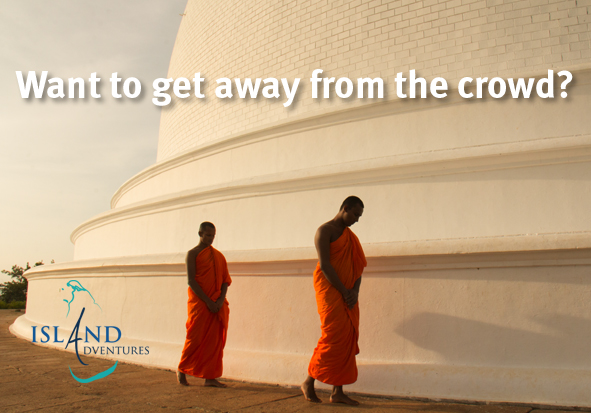TRAVEL
Surrey’s Premier Lifestyle Magazine
Lahe Lahe land
It’s said that the easy going and laid back nature of the Assamese people is an effect of the wet, humid climate of Assam, Land of ‘lahe lahe’. This weather induces a soporific tendency amongst its people and therefore life itself is a slow, unhurried and laidback affair. Subhasish Chakraborty looks into a silent revolution that’s taken place in north-east India.
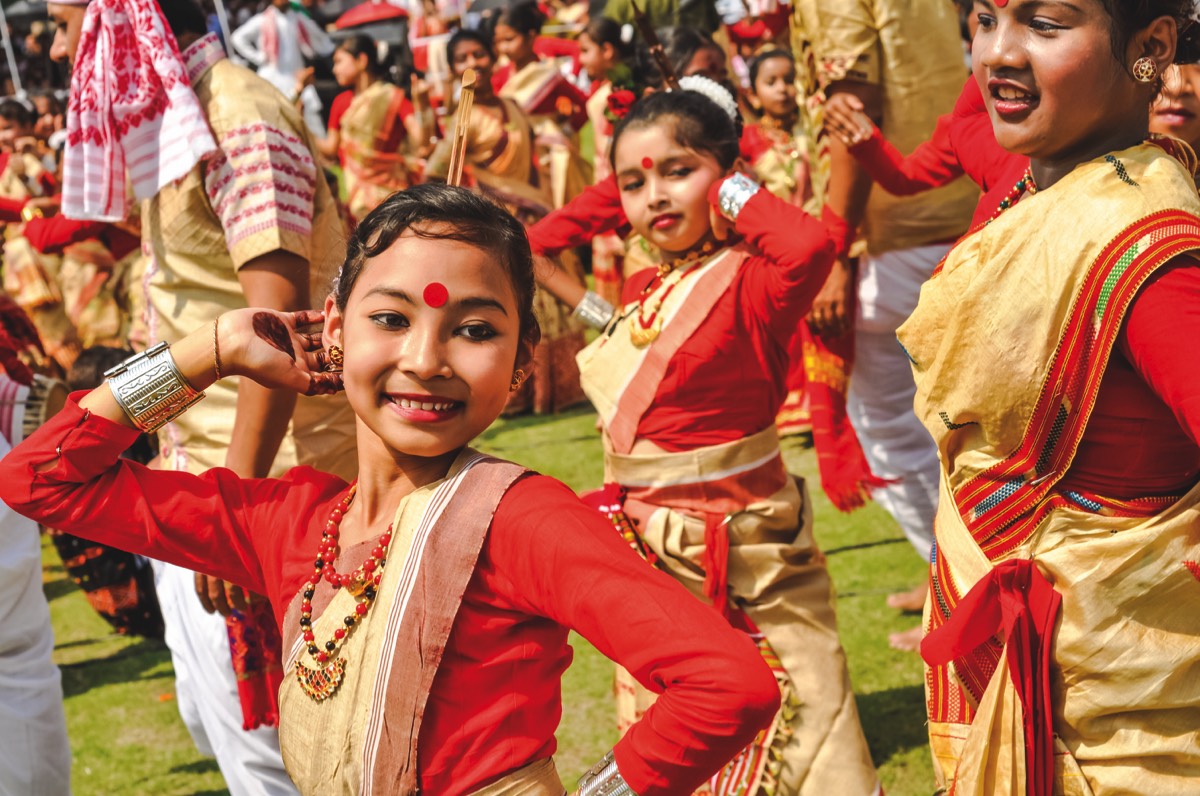
Traditional Bihu festival in Guwahati Photo Copyright: Michal Knitl | www.123rf.com
Over recent years tea tourism in Assam has played a significant role in changing common perceptions by offering a completely new experience to the usual tourist haunts. Traditional, well-trodden routes include the capital city of Guwahati with its list of must visit sites such as the holy Kamakshya, Umananda and Nabagraha temples, along with The Srimanta Sankardeva Kalakshetra cultural centre to which can be added a visit to Manas National Park.
Our week long trip to the area was organised by the professionally run River Journeys and Bungalows of India, or RJBI company, one of the first to open up this area formerly off limits to the tourist at large.
Gone are the days of ‘hotel-sightseeing and back-to-the-hotel’ experiences that my family and I were so used to. Instead of being guests of centrally located star hotels, for the first time we embraced the sheer fascination of staying at a colonial tea garden bungalow in one of the remotest tea gardens (Addabarie, Balipara) of Assam.
The Air India flight from Calcutta was on time and after reaching Guwahati we drove straight to Balipara. We covered the distance in six hours with comfort stops on the way. As our coach entered the garden premises, the sight of a beautifully appointed colonial bungalow caught our attention. This was to be our home away from home for the next two days.
The staff of RJBI informed us that this centuries old bungalow – ‘The Wild Mahseer Bungalow’ – had been thoroughly renovated in order to cater to the exacting demands of the modern traveller. Rooms were impeccably furnished with colonial style architecture and matching décor. The wooden floors, high ceilings and spacious verandahs all rekindled the nostalgia of the British Raj.
In all there are five exclusive colonial bungalows spread over an area of 22 lush green acres. The Wild Mahseer Bungalow is the principal property catering for international guests, as well as those from mainland India.
Our week long trip to the area was organised by the professionally run River Journeys and Bungalows of India, or RJBI company, one of the first to open up this area formerly off limits to the tourist at large.
Gone are the days of ‘hotel-sightseeing and back-to-the-hotel’ experiences that my family and I were so used to. Instead of being guests of centrally located star hotels, for the first time we embraced the sheer fascination of staying at a colonial tea garden bungalow in one of the remotest tea gardens (Addabarie, Balipara) of Assam.
The Air India flight from Calcutta was on time and after reaching Guwahati we drove straight to Balipara. We covered the distance in six hours with comfort stops on the way. As our coach entered the garden premises, the sight of a beautifully appointed colonial bungalow caught our attention. This was to be our home away from home for the next two days.
The staff of RJBI informed us that this centuries old bungalow – ‘The Wild Mahseer Bungalow’ – had been thoroughly renovated in order to cater to the exacting demands of the modern traveller. Rooms were impeccably furnished with colonial style architecture and matching décor. The wooden floors, high ceilings and spacious verandahs all rekindled the nostalgia of the British Raj.
In all there are five exclusive colonial bungalows spread over an area of 22 lush green acres. The Wild Mahseer Bungalow is the principal property catering for international guests, as well as those from mainland India.
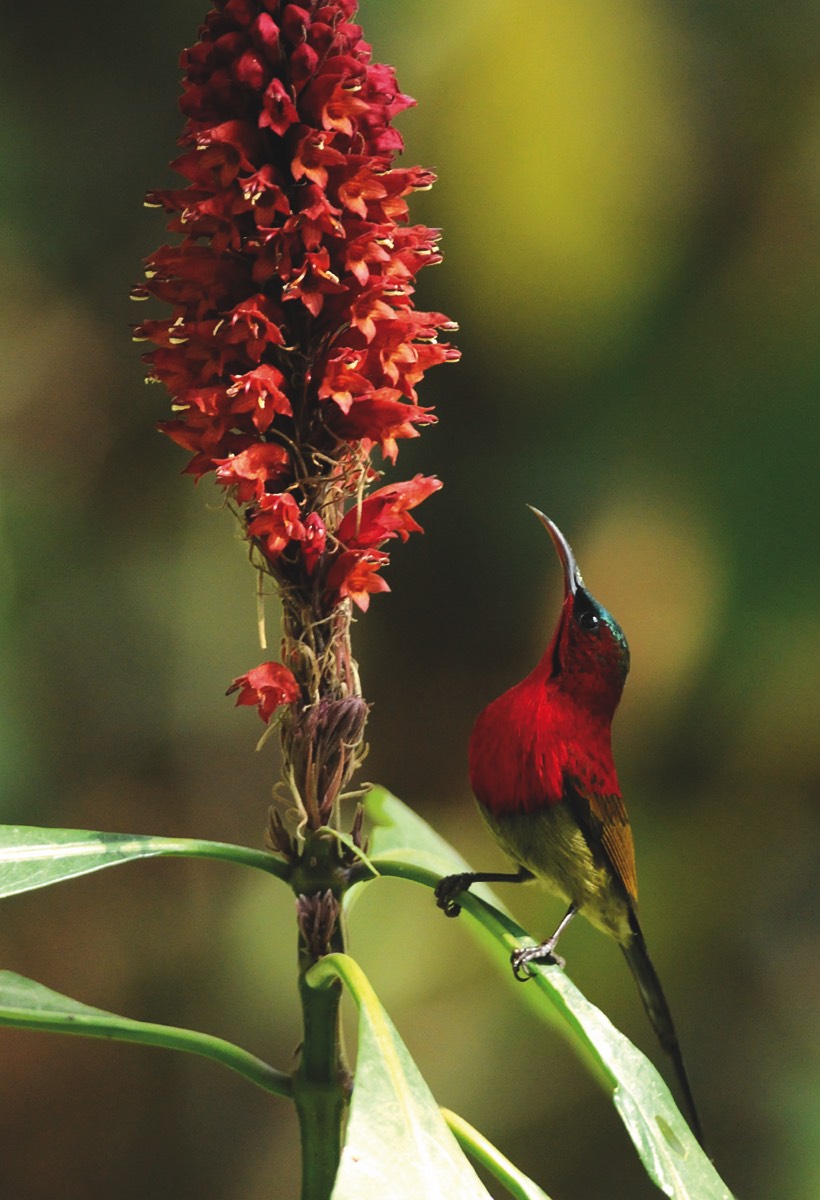
Crimson Sunbird Photo Copyright: Manas Paran | www.123rf.com
The best part of being a guest of Wild Mahseer was the fact that apart from educational tours to surrounding tea gardens, there were also a range of activities such as fishing and river rafting in the swift flowing Bhorelli River. For wildlife enthusiasts, a visit to Nameri National Park can be a very rewarding experience with all adventure activities arranged by a group of professionals from RJBI.
Most of the bungalows run by RJBI, which are well spread out throughout Assam, are situated in close proximity to the river Brahmaputra, which adds to the spirit of adventure.
The Bhorelli River is ideal for fishing with the ‘Barbus Tor’, popularly called the Mahseer, one of the largest freshwater and perhaps greatest fighting fish in the world. I personally found angling for Mahseer an exciting challenge, every cast could be a potential strike. Once the fish strikes, yards of line are tugged and the fisherman could easily snap the rod or be pulled in. Angling equipment can be hired from the bungalow.
The genesis of launching tea tourism by converting the Victorian style managers’ bungalows into heritage properties was the brainchild of Ranjit Barthakur, CEO of RJBI. According to Barthakur: “Tourists here can experience the joy of staying in the luxurious colonial ambience of the Raj era and savour the hospitality that was previously the prerogative of the British tea garden managers.” An eternal optimist, he visualised the creation of 1,000 top-end colonial heritage rooms in Assam, North Bengal and Dooars. Barthakur is also a prominent spokesman for Assam’s natural heritage, especially Kaziranga, where he advocates development that is: “carbon-negative, energy-positive, water-positive and free from land, air and water pollution.”
The entire tea industry of Assam, North Bengal and Dooars regions has woken up to tea tourism. Renowned companies such as Tata Tea, McLeod Russel, Glenburn Tea Estates and more have shown tremendous interest in this novel form of tourism.
Leaving behind the Raj era ambience of Balipara tea garden, we set off for Guwahati. The drive there was beautiful as we came across quaint Assamese hamlets as well as green rolling tea estates. Embracing the shores of the turbulent Brahmaputra, Guwahati is the gateway to the north-east and is at its festive best during the month of April in time for the all important ‘Rongali Bihu’ festival. This is the most popular festival of the people of Assam, the colourful Bihu dance at the Srimanta Sankardeva Kalakshetra was wonderful. The beating of the drums and the melodious tunes of the ‘Pepa’ reverberated in the air. The sight of beautiful Assamese women in traditional ‘Mekhela Chader’ was absolutely gorgeous. The Rongali Bihu is a tribute to Mother Nature and all the Bihu songs are basically love songs.
No visit to Guwahati is ever complete without a visit to the holy Kamakshya Temple perched atop the Nilachal Hills. After offering Puja at the sanctum sanatorium of the temple, one can admire the uninterrupted view of the city which appears like a multi hued carpet. The sight of the majestic and mighty Brahmaputra River ceaselessly flowing makes for a kaleidoscopic vignette.
As the gateway city of the north-east, Guwahati has indeed come of age. Trendy multi cuisine restaurants, neon lit bars, deluxe hotels and a youth brigade constantly evolving to the demands of the new age are characteristic of the city.
For shopping, Guwahati has numerous centrally located markets such as the Fancy Bazaar, Paltan Bazaar, Ulubari, Ganeshguri and GNB Road. A popular haunt of tourists to Guwahati is the Assam State Emporium where bamboo and cane products are extremely popular, along with shawls, wall hangings and fancy Assamese hats. Assamese silk is world famous and a must buy item for any new age woman is the quintessential Assamese ‘Mekhela Chader’.
After Guwahati we proceeded to the world famous Kaziranga National Park: a six hour journey to our rooms (booked well in advance) at the hugely popular Wild Grass Lodge (a sister concern of RJBI) where a traditional Assamese welcome awaited.
The Wild Grass Lodge is ideally located in close proximity to the National Park. Architecture is ethnic and designed in an eco-friendly manner sympathetic to the surroundings. Within the Lodge’s premises there are a variety of endangered tree species and well over two hundred species of miscellaneous flora.
Most of the bungalows run by RJBI, which are well spread out throughout Assam, are situated in close proximity to the river Brahmaputra, which adds to the spirit of adventure.
The Bhorelli River is ideal for fishing with the ‘Barbus Tor’, popularly called the Mahseer, one of the largest freshwater and perhaps greatest fighting fish in the world. I personally found angling for Mahseer an exciting challenge, every cast could be a potential strike. Once the fish strikes, yards of line are tugged and the fisherman could easily snap the rod or be pulled in. Angling equipment can be hired from the bungalow.
The genesis of launching tea tourism by converting the Victorian style managers’ bungalows into heritage properties was the brainchild of Ranjit Barthakur, CEO of RJBI. According to Barthakur: “Tourists here can experience the joy of staying in the luxurious colonial ambience of the Raj era and savour the hospitality that was previously the prerogative of the British tea garden managers.” An eternal optimist, he visualised the creation of 1,000 top-end colonial heritage rooms in Assam, North Bengal and Dooars. Barthakur is also a prominent spokesman for Assam’s natural heritage, especially Kaziranga, where he advocates development that is: “carbon-negative, energy-positive, water-positive and free from land, air and water pollution.”
The entire tea industry of Assam, North Bengal and Dooars regions has woken up to tea tourism. Renowned companies such as Tata Tea, McLeod Russel, Glenburn Tea Estates and more have shown tremendous interest in this novel form of tourism.
Leaving behind the Raj era ambience of Balipara tea garden, we set off for Guwahati. The drive there was beautiful as we came across quaint Assamese hamlets as well as green rolling tea estates. Embracing the shores of the turbulent Brahmaputra, Guwahati is the gateway to the north-east and is at its festive best during the month of April in time for the all important ‘Rongali Bihu’ festival. This is the most popular festival of the people of Assam, the colourful Bihu dance at the Srimanta Sankardeva Kalakshetra was wonderful. The beating of the drums and the melodious tunes of the ‘Pepa’ reverberated in the air. The sight of beautiful Assamese women in traditional ‘Mekhela Chader’ was absolutely gorgeous. The Rongali Bihu is a tribute to Mother Nature and all the Bihu songs are basically love songs.
No visit to Guwahati is ever complete without a visit to the holy Kamakshya Temple perched atop the Nilachal Hills. After offering Puja at the sanctum sanatorium of the temple, one can admire the uninterrupted view of the city which appears like a multi hued carpet. The sight of the majestic and mighty Brahmaputra River ceaselessly flowing makes for a kaleidoscopic vignette.
As the gateway city of the north-east, Guwahati has indeed come of age. Trendy multi cuisine restaurants, neon lit bars, deluxe hotels and a youth brigade constantly evolving to the demands of the new age are characteristic of the city.
For shopping, Guwahati has numerous centrally located markets such as the Fancy Bazaar, Paltan Bazaar, Ulubari, Ganeshguri and GNB Road. A popular haunt of tourists to Guwahati is the Assam State Emporium where bamboo and cane products are extremely popular, along with shawls, wall hangings and fancy Assamese hats. Assamese silk is world famous and a must buy item for any new age woman is the quintessential Assamese ‘Mekhela Chader’.
After Guwahati we proceeded to the world famous Kaziranga National Park: a six hour journey to our rooms (booked well in advance) at the hugely popular Wild Grass Lodge (a sister concern of RJBI) where a traditional Assamese welcome awaited.
The Wild Grass Lodge is ideally located in close proximity to the National Park. Architecture is ethnic and designed in an eco-friendly manner sympathetic to the surroundings. Within the Lodge’s premises there are a variety of endangered tree species and well over two hundred species of miscellaneous flora.
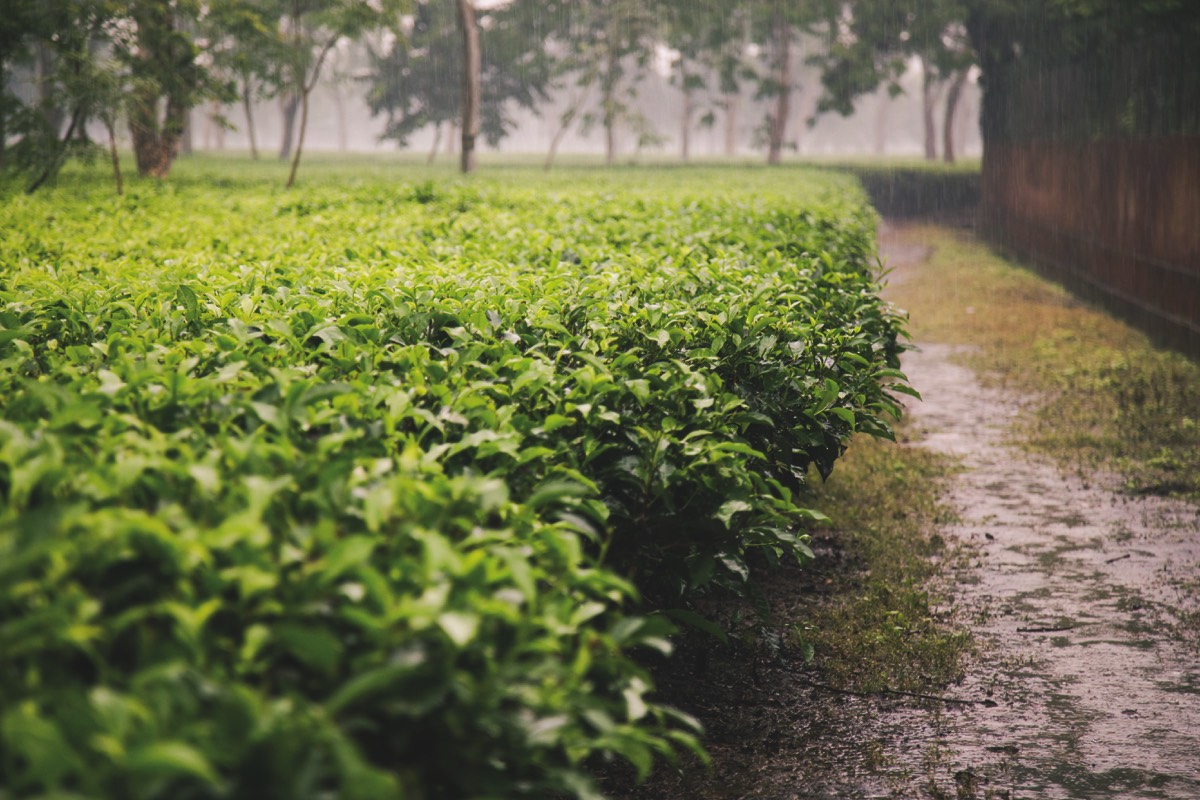
Assam history
Assam, a name some scholars claim was derived from the Sanskrit word ‘asoma’ meaning ‘peerless’ or ‘unparalleled’, is located south of the eastern Himalayas and is the home of the son of Lord Brahma, or Brahma-putra, which perhaps accounts for the Brahmaputra River being the only male river in India.The Brahmaputra’s long, verdant valley had never previously been a possession of any outside entity until the nineteenth century collapse of the Ahoms. That event led to the Burmese invasion, followed by a swift transfer to British hands in 1826 after their victory in the first Anglo-Burmese War. Almost immediately the territory became central to the economic prosperity of the Raj, as the first oil wells in Asia were discovered at Digboi and Assam became the world’s largest and most profitable tea-growing territory.
Long after India’s independence in 1947, ‘undivided’ Assam retained its colonial-era form, encompassing what is now Arunachal Pradesh, Meghalaya, Nagaland and Mizoram, with its capital in the highland city of Shillong. That all changed in 1972 with the hill regions cut away. Soon protests began across the newly defined state, led by increasingly popular movements for government action against illegal migration, especially from Bangladesh. The troubles that ensued were resolved in 1985 following the Assam accord, but there have been occasional flare ups between indigenous people and immigrants since then, notably in 2012 when around 400,00 people were displaced.
Getting there
Getting there Guwahati is well connected by air, rail and road to the rest of India.Air India offers regular flights to Guwahati from Delhi and Kolkata and the city is also well connected by rail, linked to Delhi by Rajdhani Express and North East Express. There is also a direct express train linking Guwahati to Mumbai, the Dadar Express, to Chennai by Coromandal Express, to Calcutta by Kamrup Express and Saraighat Express.
Accommodation
In Assam there are as many as 600 tea gardens spread throughout the state, but only a limited number offer bungalow accommodation to tourists.The multi cuisine restaurant offered delectable Indian, Chinese and continental food. Try traditional Assamese cuisine such as the Kamrupi Biriyani, Thekera Dia Maasor Tenga, Masor Jhool and Xoriohor Maasor Jhool all of which are perennial favourites with visitors. Assamese food is predominantly cooked in wood fire imparting exceptional flavour.
Experience jungle activities such as safaris and elephant rides inside the Park, with a team of professional naturalists who have years of experience arranging bird watching and visits to neighboring tea estates.
An early morning elephant ride is a great way of exploring the varied charms of Kaziranga which is the last bastion of the rare and elusive one-horned rhino. Apart from rhinos as many as 35 species of mammals have been spotted, with at least 15 on the verge of extinction. As we went deeper inside the forest, we spotted varied species such as Hollock Gibbons, Capped Langurs (they are cute), Bristly Hare, Sloth Bears, Swamp Deer, Sambhar and Barasingha. If in luck, visitors might even spot the elusive Gangetic Dolphins that are a treat to watch. As far as big cats are concerned, a few exist here, but it is very difficult to spot them.
The beauty of Kaziranga lies in the fact that it is covered with tall grassland and there are small streams and reservoirs (bheels) spread throughout the contours of the Park. The Savannah woodland, deciduous forest, marshy water bodies and swamps only add to its beauty.
As we were guests of RJBI, they had made arrangements for us, in co-operation with a local tea garden manager, to experience an early morning trek along the border of Hathikuli tea estate which belongs to Tata Tea. We were accompanied by a naturalist from RJBI and the manager of the garden, Joydeep Singh, and were treated to the breathtaking sight of hundreds of tribal women plucking tea leaves on to their cane baskets.
Following this, we went to the factory where the finished tea is produced. The manager educated us on the characteristic features of Assam tea and took pains to explain that the first flush has a very rich aroma, while the second flush is ideally suited for the famed ‘Tippy Teas’. Tippy Teas, we were told, refers to Black Tea with its quintessential golden tips.
True to its promise to offer an Assam we never knew existed, the RJBI team at Kaziranga Wild Grass Lodge insisted on a tribal tour of a neighboring Karbi village. We hopped in to our four-wheel drive Scorpio and in half-an-hour reached the tiny village.
The Karbis are a colourful lot. Traditional Karbis live with a belief that there is a King of their own and they await his return on earth. The hill Karbis live in traditional huts and floors are raised several feet above the ground. Karbis are very hospitable as we were to discover. Each of us was offered one gourd of liquor (Hor), which we were told is the greatest respect shown to a guest in the house of a Karbi. The manner in which the liquor was served to me was humbleness personified with the right hand of my host stretched out as the left hand held the elbow of his right hand in a salute to me, which I had to reciprocate. At the time of drinking, it is customary to throw some liquor on the ground in the name of ‘Hemphu’ the greatest god of the Karbis.
We found women weaving on traditional rude wooden looms, with one end tied to the middle part of the body of the weaver while the other end is stretched by the legs. They are known to dye threads with indigo (Sibu). As a souvenir, we bought an intricately designed Karbi shawl to the delight of the Karbi household.
The Ministry of Tourism originally spearheaded an assessment of the British era bungalows strewn across the entire north-eastern belt, including the Dooars region. The result is that tea tourism is now a niche segment in a competitive international tourism market. The RJBI company, having been one of the first, remains at the forefront offering a truly special experience.
After a history of troubles (see page 16) Assam is already a traveller’s bonanza, waiting to become global. If peace remains, the state can expect a sustained tourism boom.
Experience jungle activities such as safaris and elephant rides inside the Park, with a team of professional naturalists who have years of experience arranging bird watching and visits to neighboring tea estates.
An early morning elephant ride is a great way of exploring the varied charms of Kaziranga which is the last bastion of the rare and elusive one-horned rhino. Apart from rhinos as many as 35 species of mammals have been spotted, with at least 15 on the verge of extinction. As we went deeper inside the forest, we spotted varied species such as Hollock Gibbons, Capped Langurs (they are cute), Bristly Hare, Sloth Bears, Swamp Deer, Sambhar and Barasingha. If in luck, visitors might even spot the elusive Gangetic Dolphins that are a treat to watch. As far as big cats are concerned, a few exist here, but it is very difficult to spot them.
The beauty of Kaziranga lies in the fact that it is covered with tall grassland and there are small streams and reservoirs (bheels) spread throughout the contours of the Park. The Savannah woodland, deciduous forest, marshy water bodies and swamps only add to its beauty.
As we were guests of RJBI, they had made arrangements for us, in co-operation with a local tea garden manager, to experience an early morning trek along the border of Hathikuli tea estate which belongs to Tata Tea. We were accompanied by a naturalist from RJBI and the manager of the garden, Joydeep Singh, and were treated to the breathtaking sight of hundreds of tribal women plucking tea leaves on to their cane baskets.
Following this, we went to the factory where the finished tea is produced. The manager educated us on the characteristic features of Assam tea and took pains to explain that the first flush has a very rich aroma, while the second flush is ideally suited for the famed ‘Tippy Teas’. Tippy Teas, we were told, refers to Black Tea with its quintessential golden tips.
True to its promise to offer an Assam we never knew existed, the RJBI team at Kaziranga Wild Grass Lodge insisted on a tribal tour of a neighboring Karbi village. We hopped in to our four-wheel drive Scorpio and in half-an-hour reached the tiny village.
The Karbis are a colourful lot. Traditional Karbis live with a belief that there is a King of their own and they await his return on earth. The hill Karbis live in traditional huts and floors are raised several feet above the ground. Karbis are very hospitable as we were to discover. Each of us was offered one gourd of liquor (Hor), which we were told is the greatest respect shown to a guest in the house of a Karbi. The manner in which the liquor was served to me was humbleness personified with the right hand of my host stretched out as the left hand held the elbow of his right hand in a salute to me, which I had to reciprocate. At the time of drinking, it is customary to throw some liquor on the ground in the name of ‘Hemphu’ the greatest god of the Karbis.
We found women weaving on traditional rude wooden looms, with one end tied to the middle part of the body of the weaver while the other end is stretched by the legs. They are known to dye threads with indigo (Sibu). As a souvenir, we bought an intricately designed Karbi shawl to the delight of the Karbi household.
The Ministry of Tourism originally spearheaded an assessment of the British era bungalows strewn across the entire north-eastern belt, including the Dooars region. The result is that tea tourism is now a niche segment in a competitive international tourism market. The RJBI company, having been one of the first, remains at the forefront offering a truly special experience.
After a history of troubles (see page 16) Assam is already a traveller’s bonanza, waiting to become global. If peace remains, the state can expect a sustained tourism boom.
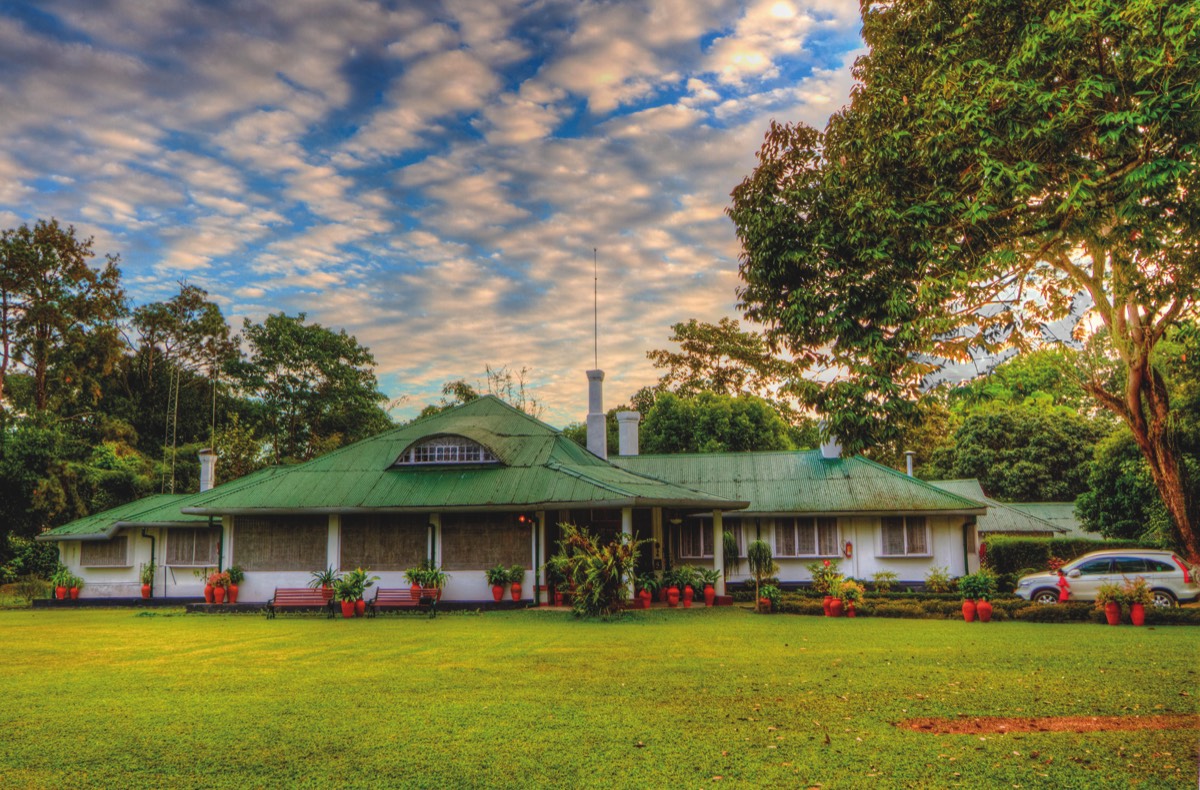
Heritage Bungalow Photo courtesy of Wild Mahseer
essence info
Wild MahseerBalipara, Assam, India
Balipara Division, Addabarie Tea Estate, P.O. Lokra, Sonitpur, Assam 784102, India
Website: www.wildmahseer.com, www.assamtourism.gov.in
Telephone: +91-3714-234354 / 234379
Mobile: +91 9435197650
E-mail: wildmahseer@gmail.com
“Tea tourism is not new in the industry, but most places offered only a couple of rooms for tourists. This was the first full-scale and serious effort to open the area up for tourists.”
Rajiv Takru, director–plantations, McLeod Russel
